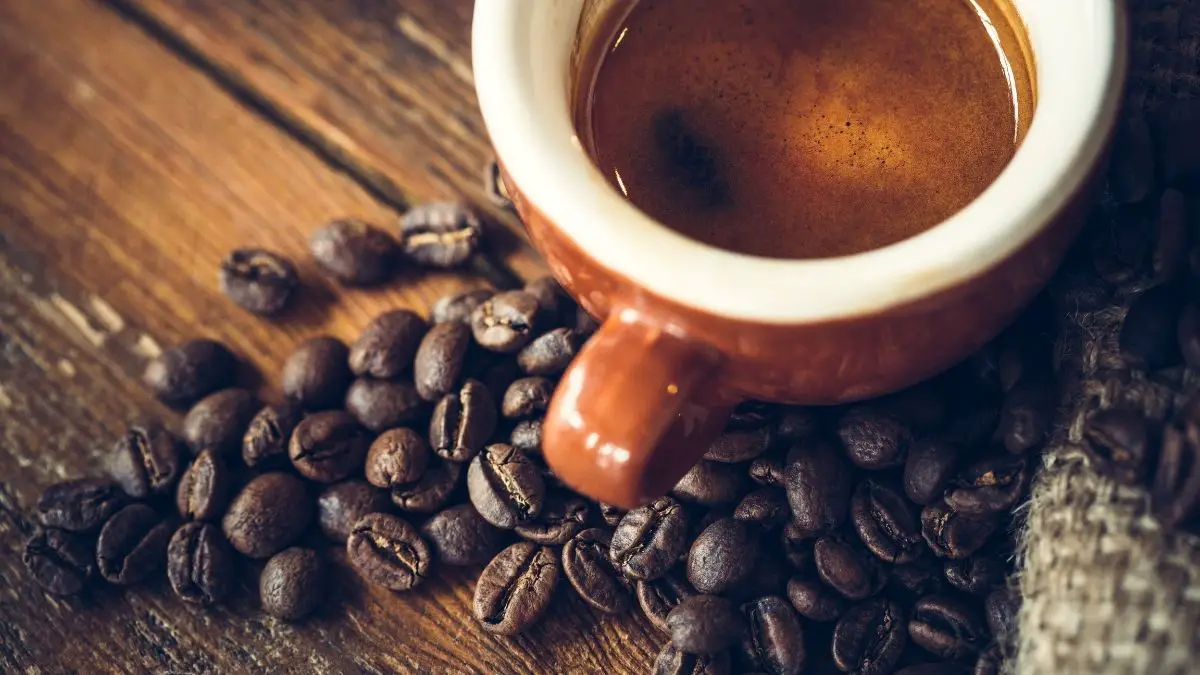Grinding coffee beans is quite the exciting part of preparing your cup of joe, especially when you have your own paraphernalia, but even when you go to your local coffee shop for a fresh brew, you may be intrigued by how they grind their beans to specific sizes, and just how many of those bits would make your coffee.
Although, baristas don’t usually measure coffee according to the number of roasted beans, but rather the weight in grams, so the bean count isn’t a very precise form of measurement as the size, weight, and roast of each bean also vary. When the beans are ground, the weight remains the same.
However, there is a general average of how many coffee beans actually go to a shot of espresso, and that’s about 70 beans per 8 grams of espresso grounds. Interestingly, this is also around the same number of beans that comprise your eight-ounce cup of dripped joe.
So you can easily see how espresso heads over drip in terms of concentration. However, there is no competition between espresso and drip as you’re free to choose whichever you prefer, but it’s also good for you to know how strong espresso truly is, as most of the coffee beverages you drink probably use a double shot of espresso as a base.
Measuring Coffee Before Brewing
Espresso is essentially a coffee concentrate with a thick body, a light crema, and a strong complexity of flavors. Due to the intricacy of an espresso shot, it’s mainly brewed through a special machine that produces 9 times worth the atmospheric pressure at sea level, or about 130 psi. This immense pressure pushes water through a portafilter that contains the finely ground coffee and extracts a flavorful shot of espresso. While a foamy layer develops on top due to the emulsification of coffee oils under high pressure.
What makes espresso a highly-concentrated beverage is its coffee to water ratio, in which 1 gram of coffee grounds should pair with 2 grams of water. This commercial standard of an espresso shot, according to the Specialty Coffee Association, is very small in comparison with other coffee beverages; drip or pour-overs require 1:8 or 2:8, a French press calls for 1:10, and cold brew is 9:40. Meanwhile, an espresso ristretto is even more concentrated at 1:1, and the lungo or long shot of espresso is 1:4.
How many grams of espresso goes into a standard double shot? Well, that could be around 16 grams and yield about a 2.2 ounce of espresso. This small serving in a demitasse cup packs a real punch of caffeine, like say, 120 mg of it. Due to this, you’re recommended to drink no more than 6 to 7 ounces of espresso, and that translates to 3 servings of cappuccino or Americano.
By the way, that recommendation came from the FDA while the University of Sleep Education says that the average American consumes 300 mg of caffeine, which is three times more than the world average, but only half of the heavy tea-drinking countries such as England and Sweden.
So the key to a coffee’s concentration is the coffee to water ratio, but the flavors may not always be dependent on those factors alone, especially when using varied grounds.
Beans, Roasts, Grounds
Coffee Beans
The weight of different beans varies, even if they’re from the same type of plant species such as the Arabica and Robusta. This doesn’t refer to roast yet, but rather the size and density of compounds, each bean holds. However, thanks to advanced processing equipment and careful labor, we are assured that we’re getting only the best and weightiest beans harvested from coffee plants.
It’s also widely known that Arabica beans are heavier than Robusta because they are larger and have a greater density of flavor compounds, which is why Arabica beans usually seem tanner than Robusta. Even after roasting, expert coffee scientists and baristas can tell Arabica and Robusta apart by their size, weight, and appearance. However, coffee made from Robusta has 25% more caffeine content, is cheaper, but also lacks sweetness and the acidity that aficionados adore.
While the average size of a coffee bean is roughly 10mm long and 6mm wide, the weight of each bean range from 0.12 g to 0.17 g, near the lesser side when roasted more, and to the larger when fresh and green. Coffee beans also shrink when roasted continuously.
Espresso uses Arabica beans and according to the SCA standards, Robusta is not a necessary component in espresso-making, although others may add it, it would feel like a cheap way to boost the caffeine content and crema of an espresso.
Coffee Roasts
Light Roast
Some espresso blends do make use of light roast grounds, but they’re uncommon since people are more accustomed to having a darker roast espresso which creates a more visible crema, a fuller body, and stronger flavors and aromas. A light roast coffee also usually tastes fruitier and more acidic than darker roasts, and this isn’t the common anticipation that most people hold for espresso.
This roast type only reaches the first crack at 400° F before it’s cooled and degassed. They have a pale-brown color and an ample lack of moisture, but they don’t possess the oily sheen that is most visible in darker roasts. Because they haven’t released as much moisture and complex compounds compared to their tanner cousins, they would usually be slightly heavier at around 0.14 or 0.15 grams per bean, and so you could be using a bit fewer beans with a light roast coffee when brewing to measure.
Medium Roast
The most common type used for espresso is a medium roast that possesses a darker brown complexion than a light roast but still lacks the oily sheen. Medium roasts are cooked till they reach the second crack at 430° F and so they possess less caffeine and acidity because more compounds are broken down by heat and some escape as volatile gases, creating the crackling noises.
Medium roast espresso is what you’d mostly have from standard cafes, and the blend tastes great with a balance of sweet, nutty, and bitter notes. What you would most likely enjoy with this is the luscious crema that orients your tongue to the complex and thick flavors of the shot.
Medium roast coffee beans would usually weigh around 0.13 or 0.14 grams per bean after achieving the second crack.
Medium-Dark Roast
When medium roast coffee is cooked slightly longer and hotter, it would start to develop the characteristic oily sheen that signals the presence of coffee oils emanating from the beans. It’s also at this point that the hype of aromas escapes the beans, resulting in much less acidity, bolder, biting flavors, and sadly, fewer antioxidants.
Depending on their origins, the beans may possess bittersweet flavors with hints of spice, chocolate, or hazelnut. When brewed, the grounds would generate a fuller body that immediately exposes the taste profile of the roasted beans. Due to these traits, medium-dark roasts could be the best choice for an espresso shot as they give out the true meaning of the shot with the satisfying thickness, flavor density, and bold aroma.
Medium-dark roasts weigh the same as their less-roasted siblings, with the only variables being the type of coffee such as Robusta, or perhaps the origins of the beans such as country, climate, and elevation. Some countries and climates do produce larger varieties, while coffee growing in lower elevations tends to be smaller.
So when we say “standard” of espresso, we’re talking about either medium or medium-dark roast coffee and you’d typically get around 70 shots of espresso at most in a 1kg bag of coffee beans, ground or not. There are approximately 8800 beans in a 1 kg bag.
Grounds
Espresso calls for powdery grounds called “fine” sized, and this is so they can be pressed snuggly into a portafilter for an even coffee bed and uniform extraction. This is very important as if too many large spaces are intact, then the water may not equally saturate the grounds, thus creating an imbalance of tastes. The step is so crucial that some baristas would even flip the portafilter to see how tightly the grounds are packed so they won’t fall off.
Because of the fine grounds and high-pressure water used in espresso brewing, this gives us an adequate amount of flavor and texture despite the extraction lasting less than 30 seconds. An espresso shot wouldn’t always taste acidic either as a lot of those components have either been broken down or escaped during roasting. Rather, the coffee would have bittersweet tastes thanks to the present oils that emulsify as crema on top of the cup.
Down the bottom, you will find the heart of the espresso which is the concentration of its chocolatey and caramel flavors that you’d enjoy if you appreciate them well enough.
Grinding your beans won’t affect their weight whatsoever, you do have to note your measurements if you commonly use pre-ground coffee. This is why you can’t “eye” a measurement of coffee because finer grounds may appear flatter and lesser than coarser ones, but they could be heavier if you weigh them correctly.
Bottom Line
Grinding coffee is perhaps the most interesting and intricate process of making your joe, and this is because the taste in your cup would depend largely on the type and size of grounds you use. Even if you’re using the same type of beans, grinding them differently would produce different concentrations of flavors and aroma depending on measurements.
However, you don’t have to fret over this as what makes coffee more fun is when you experiment and learn it yourself. Failing and making a warped expression are parts of it. So you just have to enjoy what you do and see what you can do better.

